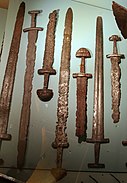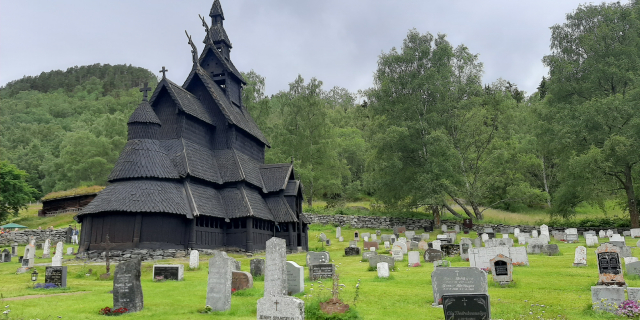Norge
NorwayContext of Norway
Norway, officially the Kingdom of Norway, is a Nordic country in Northern Europe, the mainland territory of which comprises the western and northernmost portion of the Scandinavian Peninsula. The remote Arctic island of Jan Mayen and the archipelago of Svalbard also form part of Norway. Bouvet Island, located in the Subantarctic, is a dependency of Norway; it also lays claims to the Antarctic territories of Peter I Island and Queen Maud Land. The capital and largest city in Norway is Oslo.
Norway has a total area of 385,207 square kilometres (148,729 sq mi) and had a population of 5,488,984 in January 2023. The country shares a long eastern border with Sweden at a length of 1,619 km (1,006 mi). It is bordered by Finland and Russia to the northeast and the Skagerrak strait to the south, on the other side of which are Denmark and the United Kingdom. Norway has an extensiv...Read more
Norway, officially the Kingdom of Norway, is a Nordic country in Northern Europe, the mainland territory of which comprises the western and northernmost portion of the Scandinavian Peninsula. The remote Arctic island of Jan Mayen and the archipelago of Svalbard also form part of Norway. Bouvet Island, located in the Subantarctic, is a dependency of Norway; it also lays claims to the Antarctic territories of Peter I Island and Queen Maud Land. The capital and largest city in Norway is Oslo.
Norway has a total area of 385,207 square kilometres (148,729 sq mi) and had a population of 5,488,984 in January 2023. The country shares a long eastern border with Sweden at a length of 1,619 km (1,006 mi). It is bordered by Finland and Russia to the northeast and the Skagerrak strait to the south, on the other side of which are Denmark and the United Kingdom. Norway has an extensive coastline, facing the North Atlantic Ocean and the Barents Sea. The maritime influence dominates Norway's climate, with mild lowland temperatures on the sea coasts; the interior, while colder, is also significantly milder than areas elsewhere in the world on such northerly latitudes. Even during polar night in the north, temperatures above freezing are commonplace on the coastline. The maritime influence brings high rainfall and snowfall to some areas of the country.
Harald V of the House of Glücksburg is the current King of Norway. Jonas Gahr Støre has been prime minister since 2021, replacing Erna Solberg. As a unitary sovereign state with a constitutional monarchy, Norway divides state power between the parliament, the cabinet and the supreme court, as determined by the 1814 constitution. The kingdom was established in 872 as a merger of many petty kingdoms and has existed continuously for 1,151 years. From 1537 to 1814, Norway was a part of the Kingdom of Denmark–Norway, and, from 1814 to 1905, it was in a personal union with the Kingdom of Sweden. Norway was neutral during the First World War, and also in World War II until April 1940 when the country was invaded and occupied by Nazi Germany until the end of the war.
Norway has both administrative and political subdivisions on two levels: counties and municipalities. The Sámi people have a certain amount of self-determination and influence over traditional territories through the Sámi Parliament and the Finnmark Act. Norway maintains close ties with both the European Union and the United States. Norway is also a founding member of the United Nations, NATO, the European Free Trade Association, the Council of Europe, the Antarctic Treaty, and the Nordic Council; a member of the European Economic Area, the WTO, and the OECD; and a part of the Schengen Area. In addition, the Norwegian languages share mutual intelligibility with Danish and Swedish.
Norway maintains the Nordic welfare model with universal health care and a comprehensive social security system, and its values are rooted in egalitarian ideals. The Norwegian state has large ownership positions in key industrial sectors, having extensive reserves of petroleum, natural gas, minerals, lumber, seafood, and fresh water. The petroleum industry accounts for around a quarter of the country's gross domestic product (GDP). On a per-capita basis, Norway is the world's largest producer of oil and natural gas outside of the Middle East.
The country has the fourth-highest per-capita income in the world on the World Bank and IMF lists. It has the world's largest sovereign wealth fund, with a value of US$1 trillion. Although the majority of Norway's population is ethnic Norwegian, in the 21st century immigration has accounted for more than half of population growth; in 2021, the five largest minority groups in the country were the descendants of Polish, Lithuanian, Somali, Pakistani, and Swedish immigrants.
More about Norway
- Currency Norwegian krone
- Native name Norge
- Calling code +47
- Internet domain .no
- Mains voltage 230V/50Hz
- Democracy index 9.81
- Population 5550203
- Area 385207
- Driving side right
- Prehistory
 Extent of the Ahrensburg culture 12,900–11,700 BC
Extent of the Ahrensburg culture 12,900–11,700 BCThe first inhabitants were the Ahrensburg culture (11th to 10th millennia...Read more
PrehistoryRead less Extent of the Ahrensburg culture 12,900–11,700 BC
Extent of the Ahrensburg culture 12,900–11,700 BCThe first inhabitants were the Ahrensburg culture (11th to 10th millennia BC), which was a late Upper Paleolithic culture during the Younger Dryas, the last period of cold at the end of the Weichselian glaciation. The culture is named after the village of Ahrensburg, 25 km (15.53 mi) northeast of Hamburg in the German state of Schleswig-Holstein, where wooden arrow shafts and clubs have been excavated.[1] The earliest traces of human occupation in Norway are found along the coast, where the huge ice shelf of the last ice age first melted between 11,000 and 8,000 BC. The oldest finds are stone tools dating from 9,500 to 6,000 BC, discovered in Finnmark (Komsa culture) in the north and Rogaland (Fosna culture) in the southwest. However, theories about two altogether different cultures (the Komsa culture north of the Arctic Circle being one and the Fosna culture from Trøndelag to Oslofjord being the other) were rendered obsolete in the 1970s.[2]
More recent finds along the entire coast revealed to archaeologists that the difference between the two can simply be ascribed to different types of tools and not to different cultures. Coastal fauna provided a means of livelihood for fishermen and hunters, who may have made their way along the southern coast about 10,000 BC when the interior was still covered with ice. It is now thought that these so-called "Arctic" peoples came from the south and followed the coast northward considerably later.
In the southern part of the country are dwelling sites dating from about 5,000 BC. Finds from these sites give a clearer idea of the life of the hunting and fishing peoples. The implements vary in shape and mostly are made of different kinds of stone; those of later periods are more skilfully made. Rock carvings (i.e. petroglyphs) have been found, usually near hunting and fishing grounds. They represent game such as deer, reindeer, elk, bears, birds, seals, whales, and fish (especially salmon and halibut), all of which were vital to the way of life of the coastal peoples. The rock carvings at Alta in Finnmark, the largest in Scandinavia, were made at sea level from 4,200 to 500 BC and mark the progression of the land as the sea rose after the last ice age ended.
Bronze Age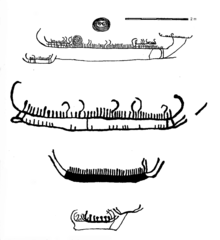 Nordic Bronze Age rock carvings at Steinkjer, Central Norway
Nordic Bronze Age rock carvings at Steinkjer, Central NorwayBetween 3000 and 2500 BC, new settlers (Corded Ware culture) arrived in eastern Norway. They were Indo-European farmers who grew grain and kept cows and sheep. The hunting-fishing population of the west coast was also gradually replaced by farmers, though hunting and fishing remained useful secondary means of livelihood.
From about 1500 BC, bronze was gradually introduced, but the use of stone implements continued; Norway had few riches to barter for bronze goods, and the few finds consist mostly of elaborate weapons and brooches that only chieftains could afford. Huge burial cairns built close to the sea as far north as Harstad and also inland in the south are characteristic of this period. The motifs of the rock carvings differ slightly from those typical of the Stone Age. Representations of the Sun, animals, trees, weapons, ships, and people are all strongly stylised.
Thousands of rock carvings from this period depict ships, and the large stone burial monuments known as stone ships, suggest that ships and seafaring played an important role in the culture at large. The depicted ships most likely represent sewn plank built canoes used for warfare, fishing and trade. These ship types may have their origin as far back as the neolithic period and they continue into the Pre-Roman Iron Age, as exemplified by the Hjortspring boat.[3]
Iron Age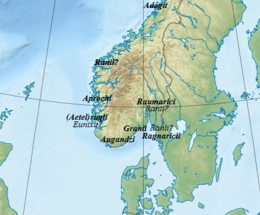 Locations of the Germanic tribes described by Jordanes in Norway
Locations of the Germanic tribes described by Jordanes in NorwayLittle has been found dating from the early Iron Age (the last 500 years BC). The dead were cremated, and their graves contain few burial goods. During the first four centuries AD, the people of Norway were in contact with Roman-occupied Gaul. About 70 Roman bronze cauldrons, often used as burial urns, have been found. Contact with the civilised countries farther south brought a knowledge of runes; the oldest known Norwegian runic inscription dates from the third century. At this time, the amount of settled area in the country increased, a development that can be traced by coordinated studies of topography, archaeology, and place-names. The oldest root names, such as nes, vik, and bø ("cape," "bay," and "farm"), are of great antiquity, dating perhaps from the Bronze Age, whereas the earliest of the groups of compound names with the suffixes vin ("meadow") or heim ("settlement"), as in Bjǫrgvin (Bergen) or Sǿheim (Seim), usually date from the first century AD.
Archaeologists first made the decision to divide the Iron Age of Northern Europe into distinct pre-Roman and Roman Iron Ages after Emil Vedel unearthed a number of Iron Age artefacts in 1866 on the island of Bornholm.[4] They did not exhibit the same permeating Roman influence seen in most other artefacts from the early centuries AD, indicating that parts of northern Europe had not yet come into contact with the Romans at the beginning of the Iron Age.
Migration periodThe destruction of the Western Roman Empire by the Germanic peoples in the fifth century is characterised by rich finds, including tribal chiefs' graves containing magnificent weapons and gold objects.[citation needed] Hill forts were built on precipitous rocks for defence. Excavation has revealed stone foundations of farmhouses 18 to 27 metres (59 to 89 ft) long—one even 46 metres (151 feet) long—the roofs of which were supported on wooden posts. These houses were family homesteads where several generations lived together, with people and cattle under one roof.[citation needed]
These states were based on either clans or tribes (e.g., the Horder of Hordaland in western Norway). By the ninth century, each of these small states had things (local or regional assemblies) for negotiating and settling disputes. The thing meeting places, each eventually with a hörgr (open-air sanctuary) or a heathen hof (temple; literally "hill"), were usually situated on the oldest and best farms, which belonged to the chieftains and wealthiest farmers. The regional things united to form even larger units: assemblies of deputy yeomen from several regions. In this way, the lagting (assemblies for negotiations and lawmaking) developed. The Gulating had its meeting place by Sognefjord and may have been the centre of an aristocratic confederation[citation needed] along the western fjords and islands called the Gulatingslag. The Frostating was the assembly for the leaders in the Trondheimsfjord area; the Earls of Lade, near Trondheim, seem to have enlarged the Frostatingslag by adding the coastland from Romsdalsfjord to Lofoten.[citation needed]
Viking AgeThe Oseberg ship at the Viking Ship Museum in OsloViking swords found in Norway, preserved at the Bergen MuseumFrom the eighth to the tenth century, the wider Scandinavian region was the source of Vikings. The looting of the monastery at Lindisfarne in Northeast England in 793 by Norse people has long been regarded as the event which marked the beginning of the Viking Age.[5] This age was characterised by expansion and emigration by Viking seafarers. They colonised, raided, and traded in all parts of Europe. Norwegian Viking explorers discovered Iceland by accident in the ninth century when heading for the Faroe Islands, and eventually came across Vinland, known today as Newfoundland, in Canada. The Vikings from Norway were most active in the northern and western British Isles and eastern North America isles.[6]
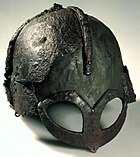 The Gjermundbu helmet found in Buskerud is the only known reconstructable Viking Age helmet.
The Gjermundbu helmet found in Buskerud is the only known reconstructable Viking Age helmet.According to tradition, Harald Fairhair unified them into one in 872 after the Battle of Hafrsfjord in Stavanger, thus becoming the first king of a united Norway.[7] Harald's realm was mainly a South Norwegian coastal state. Fairhair ruled with a strong hand and according to the sagas, many Norwegians left the country to live in Iceland, the Faroe Islands, Greenland, and parts of Britain and Ireland. The modern-day Irish cities of Dublin, Limerick and Waterford were founded by Norwegian settlers.[8]
Norse traditions were replaced slowly by Christian ones in the late 10th and early 11th centuries. One of the most important sources for the history of the 11th century Vikings is the treaty between the Icelanders and Olaf Haraldsson, king of Norway circa 1015 to 1028.[9] This is largely attributed to the missionary kings Olav Tryggvasson and St. Olav. Haakon the Good was Norway's first Christian king, in the mid-10th century, though his attempt to introduce the religion was rejected. Born sometime in between 963 and 969, Olav Tryggvasson set off raiding in England with 390 ships. He attacked London during this raiding. Arriving back in Norway in 995, Olav landed in Moster. There he built a church which became the first Christian church ever built in Norway. From Moster, Olav sailed north to Trondheim where he was proclaimed King of Norway by the Eyrathing in 995.[10]
Feudalism never really developed in Norway or Sweden, as it did in the rest of Europe. However, the administration of government took on a very conservative feudal character. The Hanseatic League forced the royalty to cede to them greater and greater concessions over foreign trade and the economy. The League had this hold over the royalty because of the loans the Hansa had made to the royalty and the large debt the kings were carrying. The League's monopolistic control over the economy of Norway put pressure on all classes, especially the peasantry, to the degree that no real burgher class existed in Norway.[11]
Civil war and peak of power The Norwegian Kingdom at its greatest extent during the 13th century, including the Open Border with the Novgorod Republic
The Norwegian Kingdom at its greatest extent during the 13th century, including the Open Border with the Novgorod RepublicFrom the 1040s to 1130, the country was at peace.[12] In 1130, the civil war era broke out on the basis of unclear succession laws, which allowed all the king's sons to rule jointly. For periods there could be peace, before a lesser son allied himself with a chieftain and started a new conflict. The Archdiocese of Nidaros was created in 1152 and attempted to control the appointment of kings.[13] The church inevitably had to take sides in the conflicts, with the civil wars also becoming an issue regarding the church's influence of the king. The wars ended in 1217 with the appointment of Håkon Håkonsson, who introduced clear law of succession.[14]
From 1000 to 1300, the population increased from 150,000 to 400,000, resulting both in more land being cleared and the subdivision of farms. While in the Viking Age all farmers owned their own land, by 1300, seventy percent of the land was owned by the king, the church, or the aristocracy. This was a gradual process which took place because of farmers borrowing money in poor times and not being able to repay. However, tenants always remained free men and the large distances and often scattered ownership meant that they enjoyed much more freedom than continental serfs. In the 13th century, about twenty percent of a farmer's yield went to the king, church and landowners.[15]
The 14th century is described as Norway's Golden Age, with peace and increase in trade, especially with the British Islands, although Germany became increasingly important towards the end of the century. Throughout the High Middle Ages, the king established Norway as a sovereign state with a central administration and local representatives.[16]
In 1349, the Black Death spread to Norway and had within a year killed a third of the population. Later plagues reduced the population to half the starting point by 1400. Many communities were entirely wiped out, resulting in an abundance of land, allowing farmers to switch to more animal husbandry. The reduction in taxes weakened the king's position,[17] and many aristocrats lost the basis for their surplus, reducing some to mere farmers. High tithes to church made it increasingly powerful and the archbishop became a member of the Council of State.[18]
Bryggen in Bergen, once the centre of trade in Norway under the Hanseatic League trade network, now preserved as a World Heritage SiteThe Hanseatic League took control over Norwegian trade during the 14th century and established a trading centre in Bergen. In 1380, Olaf Haakonsson inherited both the Norwegian and Danish thrones, creating a union between the two countries.[18] In 1397, under Margaret I, the Kalmar Union was created between the three Scandinavian countries. She waged war against the Germans, resulting in a trade blockade and higher taxation on Norwegian goods, which resulted in a rebellion. However, the Norwegian Council of State was too weak to pull out of the union.[19]
Margaret pursued a centralising policy which inevitably favoured Denmark, because it had a greater population than Norway and Sweden combined.[20] Margaret also granted trade privileges to the Hanseatic merchants of Lübeck in Bergen in return for recognition of her right to rule, and these hurt the Norwegian economy. The Hanseatic merchants formed a state within a state in Bergen for generations.[21] Even worse were the pirates, the "Victual Brothers", who launched three devastating raids on the port (the last in 1427).[22]
Norway slipped ever more to the background under the Oldenburg dynasty (established 1448). There was one revolt under Knut Alvsson in 1502.[23] Norwegians had some affection for King Christian II, who resided in the country for several years. Norway took no part in the events which led to Swedish independence from Denmark in the 1520s.[24]
Kalmar UnionUpon the death of Haakon V (King of Norway) in 1319, Magnus Erikson, at just three years old, inherited the throne as King Magnus VII of Norway. At the same time, a movement to make Magnus King of Sweden proved successful, and both the kings of Sweden and of Denmark were elected to the throne by their respective nobles, Thus, with his election to the throne of Sweden, both Sweden and Norway were united under King Magnus VII.[25]
In 1349, the Black Death radically altered Norway, killing between 50% and 60% of its population[26] and leaving it in a period of social and economic decline.[27] The plague left Norway very poor. Although the death rate was comparable with the rest of Europe, economic recovery took much longer because of the small, scattered population.[27] Even before the plague, the population was only about 500,000.[28] After the plague, many farms lay idle while the population slowly increased.[27] However, the few surviving farms' tenants found their bargaining positions with their landlords greatly strengthened.[27]
 The Kalmar Union, c. 1500
The Kalmar Union, c. 1500King Magnus VII ruled Norway until 1350, when his son, Haakon, was placed on the throne as Haakon VI.[29] In 1363, Haakon VI married Margaret, the daughter of King Valdemar IV of Denmark.[27] Upon the death of Haakon VI, in 1379, his son, Olaf IV, was only 10 years old.[27] Olaf had already been elected to the throne of Denmark on 3 May 1376.[27] Thus, upon Olaf's accession to the throne of Norway, Denmark and Norway entered personal union.[30] Olaf's mother and Haakon's widow, Queen Margaret, managed the foreign affairs of Denmark and Norway during the minority of Olaf IV.[27]
Margaret was working toward a union of Sweden with Denmark and Norway by having Olaf elected to the Swedish throne. She was on the verge of achieving this goal when Olaf IV suddenly died.[27] However, Denmark made Margaret temporary ruler upon the death of Olaf. On 2 February 1388, Norway followed suit and crowned Margaret.[27] Queen Margaret knew that her power would be more secure if she were able to find a king to rule in her place. She settled on Eric of Pomerania, grandson of her sister. Thus at an all-Scandinavian meeting held at Kalmar, Erik of Pomerania was crowned king of all three Scandinavian countries. Thus, royal politics resulted in personal unions between the Nordic countries, eventually bringing the thrones of Norway, Denmark, and Sweden under the control of Queen Margaret when the country entered into the Kalmar Union.
Union with DenmarkAfter Sweden broke out of the Kalmar Union in 1521, Norway tried to follow suit,[citation needed] but the subsequent rebellion was defeated, and Norway remained in a union with Denmark until 1814, a total of 434 years. During the national romanticism of the 19th century, this period was by some referred to as the "400-Year Night", since all of the kingdom's royal, intellectual, and administrative power was centred in Copenhagen in Denmark. In fact, it was a period of great prosperity and progress for Norway, especially in terms of shipping and foreign trade, and it also secured the country's revival from the demographic catastrophe it suffered in the Black Death. Based on the respective natural resources, Denmark–Norway was in fact a very good match since Denmark supported Norway's needs for grain and food supplies, and Norway supplied Denmark with timber, metal, and fish.
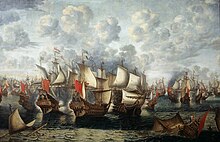 The Battle of the Sound between an allied Dano-Norwegian–Dutch fleet and the Swedish navy, 8 November 1658 (29 October OS)
The Battle of the Sound between an allied Dano-Norwegian–Dutch fleet and the Swedish navy, 8 November 1658 (29 October OS)With the introduction of Protestantism in 1536, the archbishopric in Trondheim was dissolved, and Norway lost its independence, and effectually became a colony of Denmark. The Church's incomes and possessions were instead redirected to the court in Copenhagen. Norway lost the steady stream of pilgrims to the relics of St. Olav at the Nidaros shrine, and with them, much of the contact with cultural and economic life in the rest of Europe.
Eventually restored as a kingdom (albeit in legislative union with Denmark) in 1661, Norway saw its land area decrease in the 17th century with the loss of the provinces Båhuslen, Jemtland, and Herjedalen to Sweden, as the result of a number of disastrous wars with Sweden. In the north, however, its territory was increased by the acquisition of the northern provinces of Troms and Finnmark, at the expense of Sweden and Russia.
The famine of 1695–1696 killed roughly 10% of Norway's population.[31] The harvest failed in Scandinavia at least nine times between 1740 and 1800, with great loss of life.[32]
Union with Sweden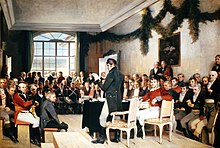 The 1814 constitutional assembly, painted by Oscar Wergeland
The 1814 constitutional assembly, painted by Oscar WergelandAfter Denmark–Norway was attacked by the United Kingdom at the 1807 Battle of Copenhagen, it entered into an alliance with Napoleon, with the war leading to dire conditions and mass starvation in 1812. As the Danish kingdom found itself on the losing side in 1814, it was forced, under terms of the Treaty of Kiel, to cede Norway to the king of Sweden, while the old Norwegian provinces of Iceland, Greenland, and the Faroe Islands remained with the Danish crown.[33] Norway took this opportunity to declare independence, adopted a constitution based on American and French models, and elected the Crown Prince of Denmark and Norway, Christian Frederick, as king on 17 May 1814. This is the famous Syttende mai (Seventeenth of May) holiday celebrated by Norwegians and Norwegian-Americans alike. Syttende mai is also called Norwegian Constitution Day.
Norwegian opposition to the great powers' decision to link Norway with Sweden caused the Norwegian–Swedish War to break out as Sweden tried to subdue Norway by military means. As Sweden's military was not strong enough to defeat the Norwegian forces outright, and Norway's treasury was not large enough to support a protracted war, and as British and Russian navies blockaded the Norwegian coast,[34] the belligerents were forced to negotiate the Convention of Moss. According to the terms of the convention, Christian Frederik abdicated the Norwegian throne and authorised the Parliament of Norway to make the necessary constitutional amendments to allow for the personal union that Norway was forced to accept. On 4 November 1814, the Parliament (Storting) elected Charles XIII of Sweden as king of Norway, thereby establishing the union with Sweden.[35] Under this arrangement, Norway kept its liberal constitution and its own independent institutions, though it shared a common monarch and common foreign policy with Sweden. Following the recession caused by the Napoleonic Wars, economic development of Norway remained slow until economic growth began around 1830.[36]
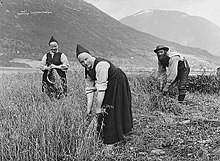 Harvesting of oats in Jølster, c. 1890
Harvesting of oats in Jølster, c. 1890This period also saw the rise of the Norwegian romantic nationalism, as Norwegians sought to define and express a distinct national character. The movement covered all branches of culture, including literature (Henrik Wergeland [1808–1845], Bjørnstjerne Bjørnson [1832–1910], Peter Christen Asbjørnsen [1812–1845], Jørgen Moe [1813–1882]), painting (Hans Gude [1825–1903], Adolph Tidemand [1814–1876]), music (Edvard Grieg [1843–1907]), and even language policy, where attempts to define a native written language for Norway led to today's two official written forms for Norwegian: Bokmål and Nynorsk.
King Charles III John, who came to the throne of Norway and Sweden in 1818, was the second king following Norway's break from Denmark and the union with Sweden. Charles John was a complex man whose long reign extended to 1844. He protected the constitution and liberties of Norway and Sweden during the age of Metternich.[neutrality is disputed] As such, he was regarded as a liberal monarch for that age. However, he was ruthless in his use of paid informers, the secret police and restrictions on the freedom of the press to put down public movements for reform—especially the Norwegian national independence movement.[37]
The Romantic Era that followed the reign of King Charles III John brought some significant social and political reforms. In 1854, women won the right to inherit property in their own right, just like men. In 1863, the last trace of keeping unmarried women in the status of minors was removed. Furthermore, women were then eligible for different occupations, particularly the common school teacher.[38] By mid-century, Norway's democracy was limited; voting was limited to officials, property owners, leaseholders and burghers of incorporated towns.[39]
 A Sámi family in Norway, c. 1900
A Sámi family in Norway, c. 1900Still, Norway remained a conservative society. Life in Norway (especially economic life) was "dominated by the aristocracy of professional men who filled most of the important posts in the central government".[40] There was no strong bourgeosie class in Norway to demand a breakdown of this aristocratic control of the economy.[41] Thus, even while revolution swept over most of the countries of Europe in 1848, Norway was largely unaffected by revolts that year.[41]
 A girl from Hardanger wearing a Norwegian bridal bunad, c. 1900
A girl from Hardanger wearing a Norwegian bridal bunad, c. 1900Marcus Thrane was a Utopian socialist. He made his appeal to the labouring classes urging a change of social structure "from below upwards." In 1848, he organised a labour society in Drammen. In just a few months, this society had a membership of 500 and was publishing its own newspaper. Within two years, 300 societies had been organised all over Norway, with a total membership of 20,000 persons. The membership was drawn from the lower classes of both urban and rural areas; for the first time these two groups felt they had a common cause.[42] In the end, the revolt was easily crushed; Thrane was captured and in 1855, after four years in jail, was sentenced to three additional years for crimes against the safety of the state. Upon his release, Marcus Thrane attempted unsuccessfully to revitalise his movement, but after the death of his wife, he migrated to the United States.[43]
In 1898, all men were granted universal suffrage, followed by all women in 1913.
Dissolution of the union and the first World WarChristian Michelsen, a shipping magnate and statesman, and Prime Minister of Norway from 1905 to 1907, played a central role in the peaceful separation of Norway from Sweden on 7 June 1905. A national referendum confirmed the people's preference for a monarchy over a republic. However, no Norwegian could legitimately claim the throne, since none of Norway's noble families could claim descent from medieval royalty. In European tradition, royal or "blue" blood is a precondition for laying claim to the throne.
The government then offered the throne of Norway to Prince Carl of Denmark, a prince of the Dano-German royal house of Schleswig-Holstein-Sonderburg-Glücksburg and a distant relative of several of Norway's medieval kings. After centuries of close ties between Norway and Denmark, a prince from the latter was the obvious choice for a European prince who could best relate to the Norwegian people. Following the plebiscite, he was unanimously elected king by the Norwegian Parliament, the first king of a fully independent Norway in 508 years (1397: Kalmar Union); he took the name Haakon VII. In 1905, the country welcomed the prince from neighbouring Denmark, his wife Maud of Wales and their young son to re-establish Norway's royal house.
Throughout the First World War, Norway remained neutral; however, diplomatic pressure from the British government meant that it heavily favoured the Allies during the war. During the war, Norway exported fish to both Germany and Britain, until an ultimatum from the British government and anti-German sentiments as a result of German submarines targeting Norwegian merchantmen led to a termination of trade with Germany. 436 Norwegian merchantmen were sunk by the Kaiserliche Marine during the war, with 1,150 Norwegian sailors losing their lives.[44][disputed ]
Second World War Scenes from the Norwegian Campaign in 1940
Scenes from the Norwegian Campaign in 1940Norway once more proclaimed its neutrality during the Second World War, but this time, it was invaded by German forces on 9 April 1940. Although Norway was unprepared for the German surprise attack (see: Battle of Drøbak Sound, Norwegian Campaign, and Invasion of Norway), military and naval resistance lasted for two months. Norwegian armed forces in the north launched an offensive against the German forces in the Battles of Narvik, until they were forced to surrender on 10 June after losing British support which had been diverted to France during the German invasion of France.
 Bombing of Kristiansund. The German invasion resulted in 24 towns being bombed in the spring of 1940.
Bombing of Kristiansund. The German invasion resulted in 24 towns being bombed in the spring of 1940.King Haakon and the Norwegian government escaped to Rotherhithe in London. Throughout the war they sent inspirational radio speeches and supported clandestine military actions in Norway against the Germans. On the day of the invasion, the leader of the small National-Socialist party Nasjonal Samling, Vidkun Quisling, tried to seize power, but was forced by the German occupiers to step aside. Real power was wielded by the leader of the German occupation authority, Reichskommissar Josef Terboven. Quisling, as minister president, later formed a collaborationist government under German control. Up to 15,000 Norwegians volunteered to fight in German units, including the Waffen-SS.[45]
The fraction of the Norwegian population that supported Germany was traditionally smaller than in Sweden, but greater than is generally appreciated today.[citation needed] It included a number of prominent personalities such as the Nobel-prize winning novelist Knut Hamsun. The concept of a "Germanic Union" of member states fit well into their thoroughly nationalist-patriotic ideology.
 Norwegian fighter pilots in the United Kingdom during World War II
Norwegian fighter pilots in the United Kingdom during World War IIMany Norwegians and persons of Norwegian descent joined the Allied forces as well as the Free Norwegian Forces. In June 1940, a small group had left Norway following their king to Britain. This group included 13 ships, five aircraft, and 500 men from the Royal Norwegian Navy. By the end of the war, the force had grown to 58 ships and 7,500 men in service in the Royal Norwegian Navy, 5 squadrons of aircraft (including Spitfires, Sunderland flying boats and Mosquitos) in the newly formed Norwegian Air Force, and land forces including the Norwegian Independent Company 1 and 5 Troop as well as No. 10 Commandos.[citation needed]
During the five years of German occupation, Norwegians built a resistance movement which fought the German occupation forces with both civil disobedience and armed resistance including the destruction of Norsk Hydro's heavy water plant and stockpile of heavy water at Vemork, which crippled the German nuclear programme (see: Norwegian heavy water sabotage). More important to the Allied war effort, however, was the role of the Norwegian Merchant Marine. At the time of the invasion, Norway had the fourth-largest merchant marine fleet in the world. It was led by the Norwegian shipping company Nortraship under the Allies throughout the war and took part in every war operation from the evacuation of Dunkirk to the Normandy landings. Every December Norway gives a Christmas tree to the United Kingdom as thanks for the British assistance during the Second World War. A ceremony takes place to erect the tree in London's Trafalgar Square.[46]
Svalbard was not occupied by German troops, but Germany secretly established a meteorological station there in 1944; the crew was stranded after the general capitulation in May 1945 and were rescued by a Norwegian seal hunter on 4 September. They were the last German soldiers to surrender in WW2.[47]
Post-World War II historyFrom 1945 to 1962, the Labour Party held an absolute majority in the parliament. The government, led by prime minister Einar Gerhardsen, embarked on a programme inspired by Keynesian economics, emphasising state financed industrialisation and co-operation between trade unions and employers' organisations. Many measures of state control of the economy imposed during the war were continued, although the rationing of dairy products was lifted in 1949, while price controls and rationing of housing and cars continued until 1960.
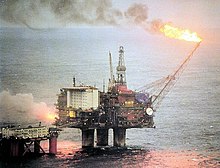 Since the 1970s oil production has helped to expand the Norwegian economy and finance the Norwegian state (Statfjord oil field).
Since the 1970s oil production has helped to expand the Norwegian economy and finance the Norwegian state (Statfjord oil field).The wartime alliance with the United Kingdom and the United States was continued in the post-war years. Although pursuing the goal of a socialist economy, the Labour Party distanced itself from the Communists, especially after the Communists' seizure of power in Czechoslovakia in 1948, and strengthened its foreign policy and defence policy ties with the US. Norway received Marshall Plan aid from the United States starting in 1947, joined the Organisation for Economic Co-operation and Development (OECD) one year later, and became a founding member of the North Atlantic Treaty Organization (NATO) in 1949.
The first oil was discovered at the small Balder field in 1967, but production only began in 1999.[48] In 1969, the Phillips Petroleum Company discovered petroleum resources at the Ekofisk field west of Norway. In 1973, the Norwegian government founded the State oil company, Statoil (now Equinor). Oil production did not provide net income until the early 1980s because of the large capital investment that was required to establish the country's petroleum industry. Around 1975, both the proportion and absolute number of workers in industry peaked. Since then labour-intensive industries and services like factory mass production and shipping have largely been outsourced.
Norway was a founding member of the European Free Trade Association (EFTA). Norway was twice invited to join the European Union, but ultimately declined to join after referendums that failed by narrow margins in 1972 and 1994.[49]
 Town Hall Square in Oslo filled with people with roses mourning the victims of the Utøya massacre of 22 July 2011.
Town Hall Square in Oslo filled with people with roses mourning the victims of the Utøya massacre of 22 July 2011.In 1981, a Conservative Party government led by Kåre Willoch replaced the Labour Party with a policy of stimulating the stagflated economy with tax cuts, economic liberalisation, deregulation of markets, and measures to curb record-high inflation (13.6% in 1981).
Norway's first female prime minister Gro Harlem Brundtland of the Labour Party continued many of the reforms of her Conservative predecessor, while backing traditional Labour concerns such as social security, high taxes, the industrialisation of nature, and feminism. By the late 1990s, Norway had paid off its foreign debt and had started accumulating a sovereign wealth fund. Since the 1990s, a divisive question in politics has been how much of the income from petroleum production the government should spend, and how much it should save.
In 2011, Norway suffered two terrorist attacks on the same day conducted by Anders Behring Breivik which struck the government quarter in Oslo and a summer camp of the Labour party's youth movement at Utøya island, resulting in 77 deaths and 319 wounded.[50]
Jens Stoltenberg, leader of the Labour Party, led Norway as Prime Minister for eight years from 2005 to 2013.[51] The 2013 Norwegian parliamentary election brought a more conservative government to power, with the Conservative Party and the Progress Party winning 43% of the electorate's votes.[52] In the Norwegian parliamentary election 2017 the centre-right government of Prime Minister Erna Solberg won re-election.[53] The 2021 Norwegian parliamentary election saw a big win for the left-wing opposition in an election fought on climate change, inequality, and oil.[54] Labour leader Jonas Gahr Støre was sworn in as new prime minister, in a centre-left minority government comprising 10 women and nine men.[55]
^ Passarino, G; Cavalleri, G. L.; Lin, A. A.; Cavalli-Sforza, L. L.; Børresen-Dale, A. L.; Underhill, P. A. (2002). "Different genetic components in the Norwegian population revealed by the analysis of mtDNA and Y chromosome polymorphisms". European Journal of Human Genetics. 10 (9): 521–529. doi:10.1038/sj.ejhg.5200834. PMID 12173029. ^ Klavs Randsborg (14 September 2009). The Anatomy of Denmark: Archaeology and History from the Ice Age to AD 2000. Bloomsbury Academic. ISBN 978-0-7156-3842-2. OCLC 1114604682. ^ Ling 2008. Elevated Rock Art. GOTARC Serie B. Gothenburg Archaeological Thesis 49. Department of Archaeology and Ancient History, University of Gothenburg, Goumlteborg, 2008. ISBN 978-9185245345. ^ Vedel, Bornholms Oldtidsminder og Oldsager, (Copenhagen 1886). ^ "Age of the vikings". loststory. Retrieved 17 February 2015. ^ "Vinland Archeology". naturalhistory.si.edu. Archived from the original on 8 March 2018. Retrieved 11 April 2017. ^ Larsen, p. 83. ^ Foster, R. F. (2001) The Oxford History of Ireland. Oxford University Press. ISBN 019280202X ^ Jones, Gwyn, A history of the Vikings (Oxford 2001). ^ Larsen, p. 95. ^ Larsen, p. 201. ^ Stenersen: 36 ^ Stenersen: 38 ^ Stenersen: 39 ^ Stenersen: 37 ^ Stenersen: 41 ^ Stenersen: 44 ^ a b Stenersen: 45 ^ Stenersen: 46 ^ Derry p. 75 ^ Derry pp. 77–78 ^ Derry p. 77 ^ Derry pp. 81–82 ^ Derry pp. 83–84 ^ Larsen, p. 192. ^ Oeding, P (1990). "The black death in Norway". Tidsskrift for den Norske Laegeforening. 110 (17): 2204–08. PMID 2197762. ^ a b c d e f g h i j "Black Death (pandemic)". Encyclopædia Britannica. Retrieved 23 July 2011. ^ Larsen, pp. 202–03. ^ Larsen, p. 195 ^ Larsen, p. 197 ^ "Finding the family in medieval and early modern Scotland". Elizabeth Ewan, Janay Nugent (2008). Ashgate Publishing. p. 153. ISBN 0754660494 ^ "The savage wars of peace: England, Japan and the Malthusian trap". Alan Macfarlane (1997). p. 63. ISBN 0631181172 ^ Treaty of Kiel, 14 January 1814. ^ Nicolson, Harold (1946). The Congress of Vienna; a study in allied unity, 1812–1822. Constable & co. ltd. p. 295. The British Government sought to overcome this reluctance by assisting Russia in blockading the coast of Norway ^ Larsen, p. 572. ^ Larsen, p. 423. ^ Franklin D. Scott, Sweden: the Nation's History (University of Minnesota Press: Minneapolis, 1977) p. 380. ^ Larsen, p. 432. ^ Larsen, p. 431. ^ Larsen, p. 412. ^ a b See "The Civil War in Switzerland" by Frederick Engels contained in Marx & Engels, Collected Works: Volume 6 (International Publishers, New York, 1976) p. 368. ^ Larsen, p. 433. ^ "Marcus Møller Thrane – Norwegian journalist and socialist". Encyclopædia Britannica. ^ * Riste, Olav. The Neutral Ally: Norway's relations with belligerent powers in the First World War (1995) ^ "Norwegian volunteers in the Wehrmacht and SS". Nuav.net. 9 April 1940. Retrieved 5 April 2010. ^ PM to light London tree. Aftenposten. 5 December 2007 ^ Frenzel, Eike (3 September 2010). "Kriegsende in der Arktis: Die vergessenen Haudegen". Spiegel Online. Retrieved 4 November 2018. ^ "Balder – Norsk Oljemuseum". www.norskolje.museum.no. Archived from the original on 7 October 2017. Retrieved 6 October 2017. ^ "Norwegian minister Espen Eide urges UK caution on quitting EU". BBC News. 23 December 2012. Retrieved 23 December 2012. ^ "Norway mourns 77 dead a decade after terrorist attack". PBS NewsHour. 22 July 2021. ^ "'Iron Erna' replaces Stoltenberg as Norway's prime minister as centre-right bloc takes power". canadianbusiness.com. 9 September 2013. Archived from the original on 13 December 2021. Retrieved 13 December 2021. ^ "Norway election: Conservative Erna Solberg triumphs". BBC News. 10 September 2013. ^ Dagenborg, Henrik Stolen, Joachim (12 September 2017). "Norway's right-wing government wins re-election fought on oil, tax". Reuters – via www.reuters.com. ^ Buli, Nora; Klesty, Victoria (14 September 2021). "Norway's left-wing opposition wins in a landslide, coalition talks next". Reuters. Retrieved 19 October 2021. ^ "Norway's prime minister presents his new government". ABC News.
- Stay safe
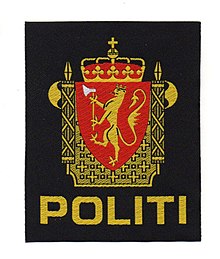 Police patch including the golden lion (insignia for government authorities)
Police patch including the golden lion (insignia for government authorities)Norway has a very low rate of violent crime. The most likely crimes for tourists to experience are car break-ins and bicycle theft. Pickpockets do also tend to be an increasing problem in urban areas in the summer season, but it's still nothing like in larger cities in Europe. It is always a good idea to look after your belongings, this includes never leaving valuable objects visible in your car and locking your bike safely. It is generally illegal to carry knives and firearms in public places such as on the street.
Single women should have no problems, although ordinary street sense is advised after dark. During summer there is full daylight until late evening, even in South Norway.
Norway is one of the countries in the world with the lowest levels of corruption. Police and other authorities cannot be bribed, travellers are strongly advised against attempting in any form of bribery.
...Read moreStay safeRead less Police patch including the golden lion (insignia for government authorities)
Police patch including the golden lion (insignia for government authorities)Norway has a very low rate of violent crime. The most likely crimes for tourists to experience are car break-ins and bicycle theft. Pickpockets do also tend to be an increasing problem in urban areas in the summer season, but it's still nothing like in larger cities in Europe. It is always a good idea to look after your belongings, this includes never leaving valuable objects visible in your car and locking your bike safely. It is generally illegal to carry knives and firearms in public places such as on the street.
Single women should have no problems, although ordinary street sense is advised after dark. During summer there is full daylight until late evening, even in South Norway.
Norway is one of the countries in the world with the lowest levels of corruption. Police and other authorities cannot be bribed, travellers are strongly advised against attempting in any form of bribery.
Norway has a unified police force ("politi"). The police force is the government authority in areas like crime, national security, major accidents, missing persons, traffic control, passports and immigration control. Police officers usually do not carry guns and during a year the police (the entire police force) use guns only a handful of times. Most cities have municipal parking attendants, too, but the attendants do not have any authority beyond fining and removing vehicles.
Norway has a lot of electric vehicles, particularly in cities, in 2019 the majority of new cars were hybrid or fully electric. These cars are very quiet and pedestrians should use their eyes, not ears, when crossing roads and streets.
Outdoor safetyThe most unusual dangers to visitors are found in nature. Every year, quite a few tourists get hurt, even killed, in the mountains or on the seas, usually after given, unheeded warnings. For example, do not approach a glacier front, big waves on the coast, or a big waterfall unless you know what you're doing, and do not walk on glaciers without proper training and equipment.
When hiking or skiing, be prepared for a sudden shift in the weather, as these can happen very quickly in Norway. Carry the gear you might need to cope. If unsure about conditions, ask locals or go on a guided tour. For any written advice, make sure you understand how your experience might differ from that of the intended audience, and e.g. what is included in estimated hike durations. You are expected to manage on your own in the Norwegian wilderness, so you won't find fences or warning signs even at the most dangerous places.
Keep in mind that avalanches are common. Unless you know exactly what you're doing, stay in marked slopes when skiing. If you think you know what you're doing, think twice. 12 people were killed in avalanches just in the first three months of 2011 in Norway. For safety measures, see below.
Wild animalsNorway has few dangerous wild animals. Car crashes with the mighty moose or the smaller red deer account for the bulk of wild animal-related deaths and injuries. In some rural districts, sheep, goats, cows or reindeer can be seen walking or sleeping on the road. Unlike other wild animals, the muskox in Dovrefjell area does not necessarily run from humans, instead they form a defensive perimeter around the group and may attack if approached.
 Warning - polar bears. "Applies to all of Svalbard", but not at all to the mainland.
Warning - polar bears. "Applies to all of Svalbard", but not at all to the mainland.Specific rules and precautions apply to Svalbard, where you should never travel outside Longyearbyen without someone in your party carrying a weapon. The polar bears on Svalbard are a real and extremely dangerous threat for the unprepared, and there are cases involving death and/or injury almost every year. There are more polar bears here than humans. Svalbard is a fragile, dry arctic tundra with large parts almost untouched by humans. The current recommendation is that non-local visitors participate on organized tour arrangements only. Breaking the law, disturbing wildlife or being reckless can land you a fine and/or deportation from the archipelago. That said, if you come well prepared with common sense, the visit will be one of the most memorable you've ever had. The nature, scenery and history of Svalbard is simply breathtaking.
As for other wild animals on mainland Norway, there are not much more than a few extremely rare encounters with brown bear and wolf in the wilderness. Contrary to popular belief abroad, there are no polar bears in mainland Norway, let alone polar bears walking city streets. The Scandinavian brown bear is peaceful and will generally run away from humans. In any case it is extremely unlikely that tourists will even see a glimpse of one of the around 50 brown bears remaining in Norway. Norwegian wolves are not dangerous to humans. In general, there is no reason to worry about dangerous encounters with wild beasts in Norway.
Sea and coast The outer coast is treacherous.
The outer coast is treacherous.Norway's immense coastline is an adventure for visitors, but also a treacherous area. Huge waves that build up power across the North Sea and the Atlantic crush on slippery rocks and slabs along the outer coast. Every year tourists are in serious danger and occasionally even killed when they challenge the big waves along the shores. Many tourists also leave the sheltered waters and venture onto the open sea in small boats, every year tourists are rescued at sea, some even perish. Note that life jackets are required in small boats. The long inner fjords are mostly sheltered from ocean waves, but sea breezes can be powerful and unpredictable on warm summer days. Complex topography makes wind unpredictable. Winds are on average strongest and most frequent during winter, but the open sea is treacherous in summer too.
Tides vary considerably between regions and are in general greater further north. In Oslofjord and around Kristiansund the difference between high and low tides is only some 50 cm. In Bergen almost 2 meters, Kristiansund some 2.5 meters, in Narvik (Nordland) and Vadsø (East Finnmark) some 4 meters. Tides can increase during strong winds and low pressure. The tide can create strong currents at narrow straits and fjord mouths (Saltstraumen at Bodø is the world's most powerful).
Nevertheless, various types of water sports are very popular, such as sailing of various kinds, surfing, rowing, canoeing, kayaking, motor boating, water skiing and so on. If the weather and temperature are favorable, outdoor swimming is also popular.
Norway has many ferry crossings and other vessels must yield to ferries. Dont go out in kayak or dive near the docks and routes of car ferries. Sail boats and small boats must also yield to larger vessels and cargo ships.
Skiing in the mountainsTo go hiking and skiing in the mountains during winter requires precautions. Snow storms and avalanches are dangerous, occur often and require safety measures. Therefore The Norwegian Trekking Association compiled The Norwegian Mountain Code (Fjellvettreglene), safety rules that significantly reduce the danger.
Glaciers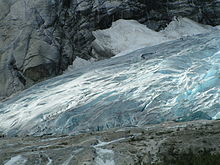 Glaciers are beautiful and fascinating, but treacherous and powerful. Note the size of hikers compared to the ice.
Glaciers are beautiful and fascinating, but treacherous and powerful. Note the size of hikers compared to the ice.Glaciers are some of the most dangerous places for visitors to the Norwegian outdoors. Never underestimate the power of glaciers. Observe warning signs. Never approach the front of the glacier. Observe warning signs and do not cross fences. Most glaciers do not have any kind of signs or fences, and visitors should keep a generous distance. A glacier is not a stable piece of ice, it is constantly moving like a very slow river and huge chunks regularly fall off. There are countless glaciers in Norway and even smaller and apparently insignificant glaciers are powerful compared to tiny humans.
Do not enter a glacier without proper equipment and a skilled local guide. Sunrays get reflected from the white snow, so it is necessary to use sunscreen to protect your skin. Bring warm clothes for tours on the glacier.
On the road For more information on driving in winter conditions, see the Winter driving article.If you plan to cross the mountains by car (for instance by driving from Oslo to Bergen) in the winter season, it is imperative that you are prepared for the journey. The conditions are harsh. Always keep a full tank of fuel, and keep warm clothes, food and drink in the car. Make sure your tires are good enough and suited for winter conditions (studded or non-studded winter tires, "all-year" tires are not enough), and that you have sufficient skills for driving in snowy and cold conditions. Roads are often closed on short notice due to weather conditions. For advice on conditions and closed roads, call 175 in Norway or check the online road reports [1] (in Norwegian only) from the Norwegian State road authorities. Remember that not all portions of the roads have cellular phone coverage.
Emergency numbers Police (Politi), ☏ 112. Fire, ☏ 110. Emergency Medical Services (Ambulance), ☏ 113. If you are unsure which number to call, ☏ 112 is the central for all surch and rescue services and will put you in contact with the correct department. For non-emergencies, the police is to be called on ☏ 02800 (in country only). For treatment of casualties or serious illness (non-emergencies) ☏ 116117 (in country only). The hearing impaired using a text telephone can reach the emergency services by ☏ 1412. Roadside assistance. In case of traffic accident you are supposed to call the police only if individuals are injured or if the crash causes a traffic jam. The police will not get involved if there are damages on the vehicles only. Falck, ☏ 02222 (in country only). Viking, ☏ 06000 (in country only). Norwegian Automobile Federation (NAF Norges Automobil-Forbund), ☏ 08505 (in country only). AAA members may call Norwegian police vehicle.
Norwegian police vehicle.





